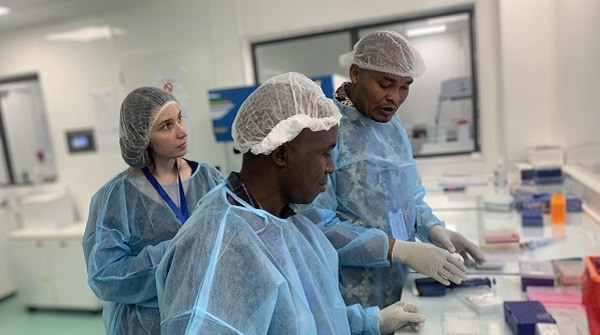At a glance
- Malaria infection is caused by Plasmodium parasite species.
- Malaria disease can be categorized as uncomplicated or severe (complicated).
- Severity of symptoms and duration of disease can depend on the species of the malaria parasite and level of immunity.
- Generally, malaria is curable if diagnosed and treated promptly and correctly.

Clinical presentation
Infection with malaria parasites may result in a wide variety of symptoms, ranging from absent or very mild symptoms to severe disease and even death. Malaria disease can be categorized as uncomplicated or severe (complicated). In general, malaria is a curable disease if diagnosed and treated promptly and correctly.
All the clinical symptoms associated with malaria are caused by the asexual erythrocytic or blood stage parasites. When the parasite develops in the erythrocyte, numerous known and unknown waste substances such as hemozoin pigment and other toxic factors accumulate in the infected red blood cell. These are dumped into the bloodstream when the infected cells lyse and release invasive merozoites. The hemozoin and other toxic factors such as glucose phosphate isomerase (GPI) stimulate macrophages and other cells to produce cytokines and other soluble factors which act to produce fever and rigors and probably influence other severe pathophysiology associated with malaria.
Plasmodium falciparum-infected erythrocytes, particularly those with mature trophozoites, adhere to the vascular endothelium of venular blood vessel walls and do not freely circulate in the blood. When this sequestration of infected erythrocytes occurs in the vessels of the brain it is believed to be a factor in causing the severe disease syndrome known as cerebral malaria, which is associated with high mortality.
Incubation Period
Following the infective bite by the female Anopheles mosquito, a period of time (the "incubation period") goes by before the first symptoms appear in a patient. The incubation period in most cases varies from 7 to 30 days. The shorter periods most frequently observed with P. falciparum and the longer ones with P. malariae.
Antimalarial drugs taken for prophylaxis by travelers are highly effective if taken as prescribed. However, antimalarial prophylaxis occasionally can delay the appearance of malaria symptoms by weeks or months, long after the traveler has left the malaria-endemic area. (This can happen particularly with P. vivax and P. ovale, both of which can produce dormant liver stage parasites; the liver stages may reactivate and cause disease months after the infective mosquito bite.)
Such long delays between exposure and development of symptoms can result in misdiagnosis or delayed diagnosis because of reduced clinical suspicion by the health-care provider. Returned travelers should always remind their healthcare providers of any travel during the past 12 months in areas where malaria occurs.
Uncomplicated Malaria
Commonly, the patient initially presents with a combination of the following symptoms (which may be mild):
- Fever
- Chills
- Sweats
- Headaches
- Nausea and vomiting
- Body aches
- General malaise
In countries where cases of malaria are infrequent, these symptoms may be attributed to influenza, a cold, or other common infections, especially if malaria is not suspected. Conversely, in countries where malaria is frequent, residents often recognize the symptoms as malaria and treat themselves without seeking diagnostic confirmation ("presumptive treatment"). Physical findings may include the following:
- Elevated temperatures
- Perspiration
- Weakness
- Enlarged spleen
- Mild jaundice
- Enlargement of the liver
- Increased respiratory rate
Diagnosis of malaria depends on the demonstration of parasites in the blood, usually by microscopy. Additional laboratory findings may include mild anemia, mild decrease in blood platelets (thrombocytopenia), elevation of bilirubin, and elevation of aminotransferases.
Severe Malaria
Progression to severe malaria occurs when infections are complicated by serious organ failures or abnormalities in the patient's blood or metabolism, usually following delays in diagnosis and treatment. Criteria for severe malaria may differ slightly depending on the country where you are practicing, see WHO Guidelines for Malaria.
For healthcare providers practicing in the U.S., the criteria for severe malaria include any one or more of the following:
- High percent parasitemia (≥5%)
- Impaired consciousness
- Seizures
- Circulatory collapse/shock
- Pulmonary edema or acute respiratory distress syndrome (ARDS)
- Acidosis
- Acute kidney injury
- Abnormal bleeding or disseminated intravascular coagulation (DIC)
- Jaundice (must be accompanied by at least one other sign)
- Severe anemia (Hb <7 g/dL)
Malaria Relapse
In P. vivax and P. ovale infections, patients having recovered from the first episode of illness may suffer several additional attacks ("relapses") after months or even years without symptoms. Relapses occur because P. vivax and P. ovale have dormant liver stage parasites ("hypnozoites") that may reactivate, infect peripheral erythrocytes, and begin a new symptomatic episode of malaria. Treatment to reduce the chance of such relapses is available and should follow treatment of the first attack.
Other manifestations of malaria
- Neurologic defects may occasionally persist (sometimes life-long) following cerebral malaria, especially in children. Such defects include trouble with movements (ataxia), palsies, speech difficulties, deafness, neurocognitive deficits, and blindness.
- Recurrent infections with P. falciparum may result in severe anemia. This occurs especially in young children in tropical Africa with frequent infections that are inadequately treated.
- Malaria during pregnancy (especially P. falciparum) may cause severe disease in the mother and may lead to premature delivery or delivery of a low-birth-weight baby.
- On rare occasions, P. vivax malaria can cause rupture of the spleen.
- Nephrotic syndrome (a chronic, severe kidney disease) can result from chronic or repeated infections with P. malariae.
- Hyperreactive malarial splenomegaly (also called "tropical splenomegaly syndrome") occurs infrequently and is attributed to an abnormal immune response to repeated malarial infections. The disease is marked by a very enlarged spleen and liver, abnormal immunologic findings, anemia, and a susceptibility to other infections (such as skin or respiratory infections).
